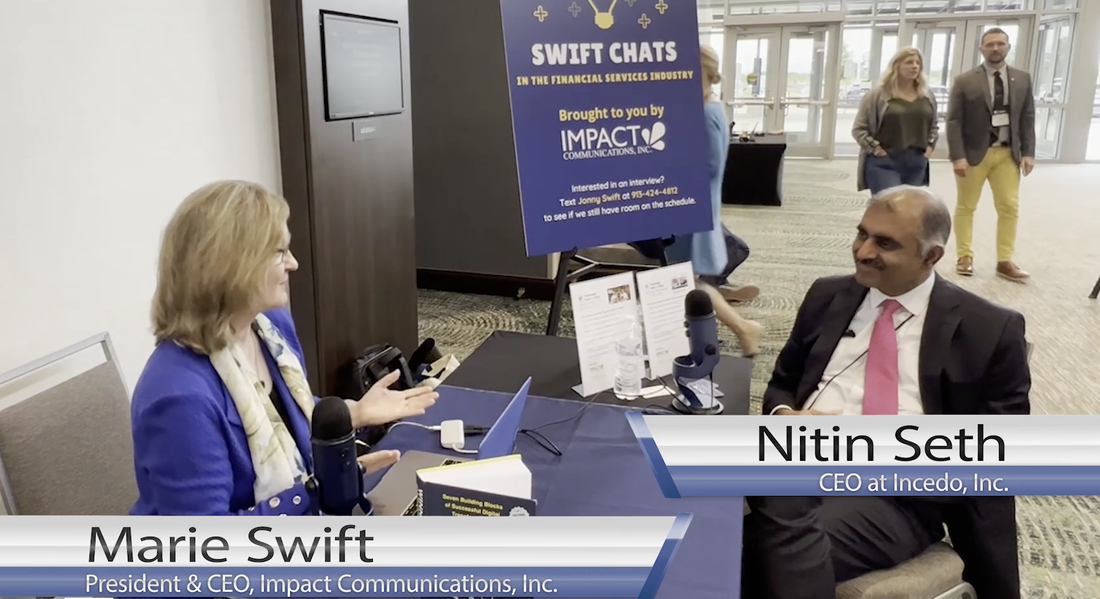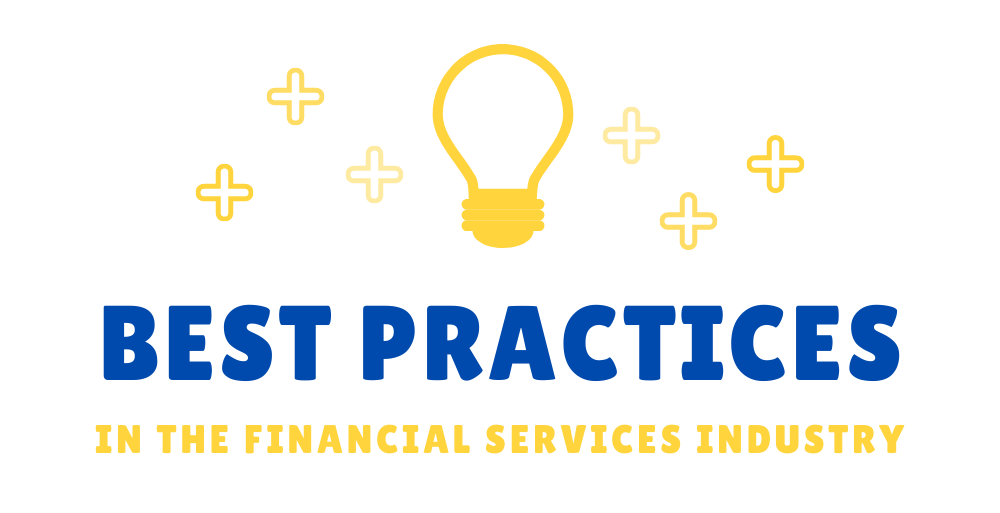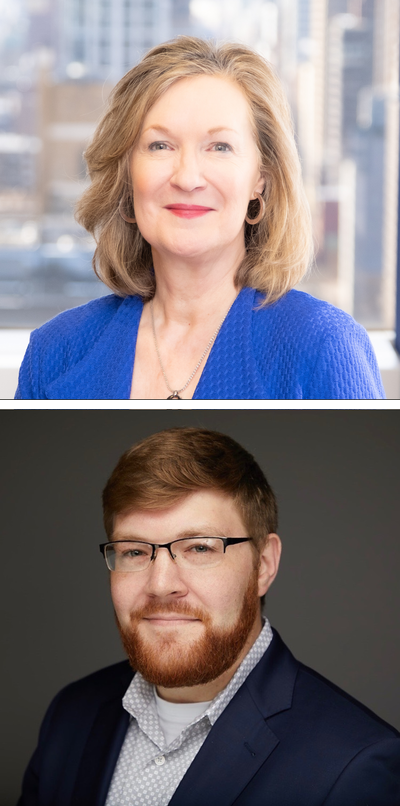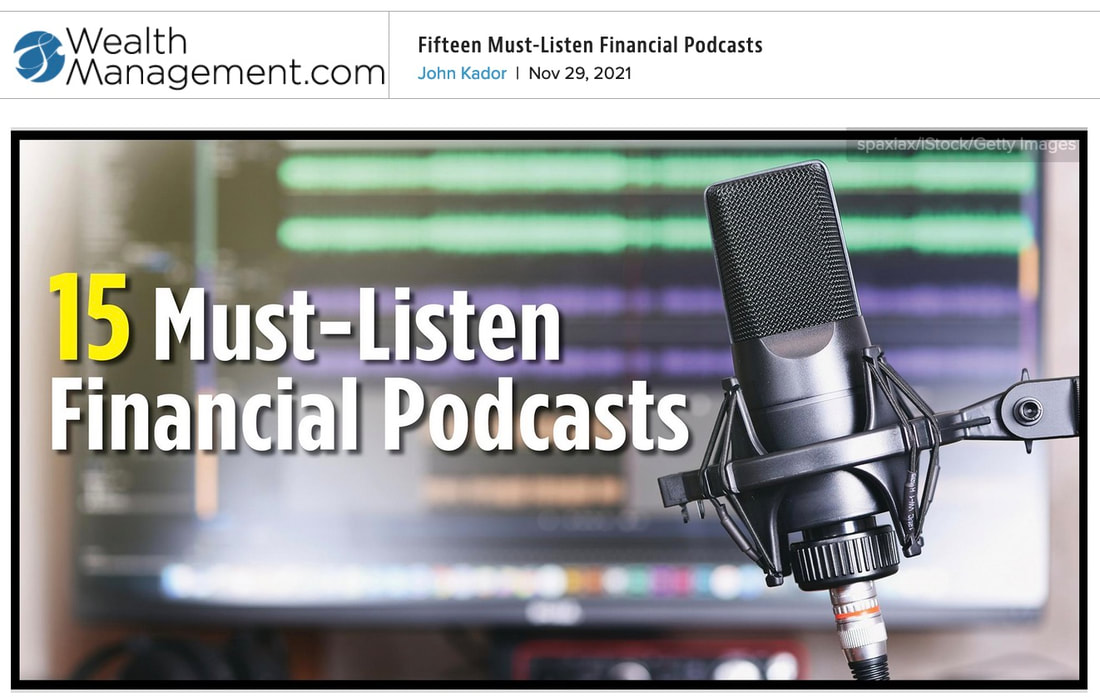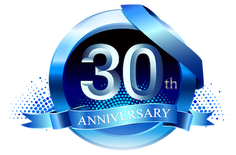|
In this Swift Chat video conversation -- recorded live at the T3 Technology Tools for Today conference in Texas on May 3, 2022 -- Marie Swift of Impact Communications, Inc. speaks with Nitin Seth, CEO of Incedo, Inc., a digital transformation company. Nitin talks about the seven building blocks of successful digital transformation and winning in the digital age.
One of the core aspects of the Incedo proposition, is how do we bring the best of breeds learnings from the digital natives in technology but also organizational learnings in to more "legacy" industries like wealth management." ~ Nitin Seth, CEO of Incedo Inc. Transcription of Conversation
Marie Swift: Nitin, welcome to Swift Chats. We're going to be talking about everything that's hot happening that you talked about here at T3. So I know you have a book that you talked about. You talked about digital transformation. You also announced a couple of very exciting things. One is the Center of Excellence, which is opening in Guadalajara, Mexico, and the other is about your artificial intelligence, I think you call it Lighthouse, Incedo Lighthouse. So would you like to begin with Lighthouse?
Nitin Seth: Absolutely. Let's shine some light on Lighthouse. So I talked about the digital age yesterday and how data is such an important aspect of the digital age. In digital age, the volume, velocity, variety of data is exploding. And that provides great opportunities of transforming that data into insights and then use those insights to deliver better outcomes for the end clients. But this is easier said than done because this volume of data is so high, that it is very easy to sin in it. So Lighthouses is an end to end platform, which allows you to bring in all the data from many different sources within your company, outside your company. And then transform that data in a form in what we call 'normalized data' so that you can do some analytics on it. Most of that analytics is now automated and that's really what AI is. And from those analytics from AI, you develop signals, you develop insights that go as next best action for the client. It then tells the client, “This is what you should do." This is how personalization happens. I think a lot of people over the last two days have talked about personalization and personalization at scale. So Lighthouse is actually the medium, the "how to" of making it happen. That from so much data, how do you really make the personalization happen? That is what Lighthouse does. So, we're very excited to bring this platform to the wealth management industry. And we have had great results with this in a number of other industries, banking, life sciences, telecom, and I'm very confident that the wealth managers would find a lot of value from Lighthouse. WHAT SETS LIGHTHOUSE APART Swift: So I'm thinking about the clients that you serve. Do you work directly with wealth managers or do you work more with the institutions that serve the wealth managers? Seth: Wealth management is a complex value chain. More of our work is with the institutions. So with the broker dealers, like an LPL or a Cetera or TAMPs like AssetMark or advisers like a Cambridge. So, who then are working with advisers. But we pretty much... I think we're in a pretty unique position that we work with industry participants across the wealth management value chain. Swift: So how does the Guadalajara facility, the Center of Excellence help with all of that? Seth: So it be a number of years that we have been analyzing the market in Latin America. And we strongly believe that Latin America, the last couple of years, has really matured from a technology perspective. And we are very excited in particular about the talent in Guadalajara. I think it's not an exaggeration to say that it is emerging as a Silicon Valley, the next Silicon Valley. It's exceptional talent, really, a number of my colleagues from Guadalajara are here at the T3 conference. I think you should meet them. You'll be very excited to meet them. So there is a there's very interesting talent, especially from a design perspective. We're very creative around design and user experience. Also talent, which is very proficient around good engineering talent. And that's the combination you need for this industry. You need that design plus data plus engineering. That really is I think the real secret weapon. And we think, Guadalajara really brings it together and brings it in close proximity to United States. And at a cost point, which is... it is a significant cost advantage over what the United States has. So we think Guadalajara is a great, great opportunity for wealth managers because wealth managers have a lot of technology talent here in the United States, they also have leveraging markets like India quite effectively. So if you look at a Fidelity or a Franklin Templeton, they have huge teams back in India, but there are a number of aspects, in a visual choir, you know closer, more time zone coverage, which required that proximity. And for that, we believe that Mexico and Guadalajara in particular would be a great asset. DIGITAL HAVES AND HAVE-NOTS Swift: So yesterday you talked about digital transformation. You have a book with a similar title. What stood out to me being in the room was where you were talking about the speed of change. And about digital natives and how you think about all of that, and you even used the term, "the digital haves and have-nots." Can you talk about the gap and how you're solving for that? Seth: Yeah, I think it's fair to say that there is a big divide between those who are-- both companies and, and people-- who are born in the digital age and those who are not. Even if you're at a very practical individual level. My 15-year-old I think is more proficient in many aspects of technology than I am. And I'm an engineer, I have been in technology for 25, 30 years. I am the CEO of one of the fastest growing technology companies in the United States. And some days I feel that 15-year-old guy knows more than I do. At least he's a lot more intuitive about it. The way he has learned technology is different. And yesterday you were mentioning to me, Marie, that you're a grandmother. So I'm sure you know this as well here. The same issue or the same, it's an opportunity actually, I think, which I just described at a personal level is also true for company. A startup doesn't have legacy. And when they are thinking about their offering, they're naturally thinking digital, when they're thinking about their operations, it is naturally straight-through-processing. It is naturally all automated and it is naturally all technology driven. So there is a very natural divide, therefore, that emerges. And now the question is how do you bridge the divide? And I think the answer is very simple. You learn from the digital natives, isn't it? You learn from the digital natives, and you see it at an individual level that in many CEOs today have this process of reverse-mentoring. Where they have like 20-year-olds in their company, who they are like partnering with and that's the reverse mentoring because they're learning what these guys, how they're thinking, how they're operating. Similarly for large companies and for industries, learning from younger companies and younger industries, I think is a great opportunity. And that is what Incedo is attempting to do. One of the core aspects of the Incedo proposition, is that, how do we bring the best of breeds learnings from the digital natives, both technology, but also organizational learnings in to quote unquote, more "legacy" industries like wealth management. LEADERSHIP LESSONS Swift: One of the other things that stood out to me with your book is about the leadership lessons and some of them are geared towards the young workforce, the young evolving entrepreneurs. So in closing, what would you leave our listeners with, our viewers with, just thinking about the times in which we live and leadership, no matter what age or stage you are in your career? Seth: Thanks for asking that. And we were talking a little bit about this yesterday, Marie, that when I wrote this book on digital transformation, I had like these seven building blocks and it includes these new rules of business and it has about industry shifts and it is about technology changes and so on and so forth, which are important, but somewhat predictable. And then I ended up writing about leadership and ended up talking about how young professionals need to think differently. A lot of people are surprised that, "Hey, in a book on digital transformation, we expect it to be a technology book-- why are you writing about this?" And I think it's a very important part of it because fundamentally, what is an enterprise? An enterprise is a collection of all of us, of individuals. You asked, I will parse your question for what it means for leaders and what it means for young professionals. For leaders there are two main implications. We've been talking about this manager-to-leader for a long time. This is an absolute reality in the digital age, because there is nothing which is defined. So what are you going to manage? You have to create, you have to create and to create, you have to take risks. And what is that called? That's called being an entrepreneur. So everybody has to be an entrepreneur in the digital age, whether you are running a startup or you are quote, unquote, a "mid-level manager" in a large corporation, you have to be effective. To be effective you have to be an entrepreneur. So that's the first message for leaders. The second message for leaders is that the digital age is very complex. So you have a lot of contradictory sets of objectives that you have to meet. You have short-term and long-term; you have growth in your profitability. You have data and you have relationships, you have people, and you have the machine, and we can keep going on and on and on. There are these seemingly contradictory sets of objectives, and you have to meet both. You can't say, "I'm going to choose one." So this ability to deal with duality, I call it 'mustering duality' which has to deal with seemingly contradictory objectives, I think is the second, very big lesson for leaders for the digital age. Now coming to young professionals, and I have three messages for them. The first message is that "Hey when the world is changing a lot, you should think about what doesn't change." You need to focus on that: what doesn't change? And something which doesn't change is problem solving. Now the specific skills will keep on changing, but there is something about how do you deal with the complexity, your ability to zone down on the core problem? So that's the first skill which I would encourage every young professional to build, which is problem solving, ability to size any complex situation and zone down on the real, the core issue to be solved. Number two is learnability. In a world where everything is constantly changing either you have to be in that constant, continuous learning journey. And your ability to pick up a new topic and go deep in it, I call it 'deliberate learning' versus general learning. That deliberate learning is one of the most critical skills for the digital age. And the third thing I would talk about are relationships. And this is a game that duality in a world of data and machines, relationships, and your emotional quotient, into your ability to connect emotionally and spiritually with the other person is that much more important. So those would be my two messages for leaders is be an entrepreneur, master duality. And my three messages for young professionals is focus on become a great problem solver, develop the skill of deliberate learning, and built relationships. Swift: Wow. Fantastic. Well, thank you so much for being here on the Swift Chat. It's been a pleasure getting to know you. Comments are closed.
|
About
|
|
Stay Connected
|
Phone: 913-649-5009
©2023 Impact Communications, Inc.
|

